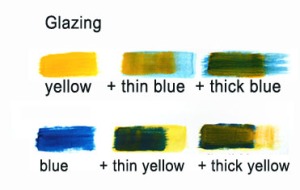Techniques
ABSTRACT ACRYLIC PAINTING TECHNIQUES
1. Mixing on the palette
The most common method for mixing paint is directly on the palette. Paints should be mixed with a palette knife rather than a brush. You can mix yellow and blue to make a green you want and then apply it to your canvas. Below you can see a few greens, which just lean towards blue or yellow. To the right below are more extreme greens.
The beauty of mixing on the palette is that nearly any variation is possible.
2. Glazing
With glazing you might start with yellow then apply a thin glaze of blue over the top. Or you can start with blue and paint yellow over the top. This technique doesn’t lend itself to the smooth, consistent green that mixing on the palette does, but it can lead to some interesting and subtle effects.
3. Dry Brushing
Dry brushing involves applying one layer of colour and letting it dry and then using a dry brush, lightly brushing another colour over the top. This forms streaking and allows the under colour to show through.
4. Wet on Wet
Wet on wet involves mixing colours directly on the canvas. Colours can also be partially mixed on the palette. This technique creates some interesting part mixes and blends of colours. The area with purple and beige is an example of wet on wet in the image below.
5. Drawing with Paint
Nozzle bottles can be filled with paint and then used to draw on the canvas. The nozzle will give you a fine point or you can cut the end to get a wider line. The Ara range of paints all come in nozzle bottles or you can make your own by buying craft bottles to fill or hair dye or sauce bottles can be thoroughly cleaned and filled with paint. In the picture above the beige/grey lines are created by using a nozzled paint bottle and drawing.
Other items can be used to draw with paint, sticks and the ends of pain brushes both create interesting types of lines by pulling through the paint surface and twisting to create different effects.
6. Dribbling
Washes can be dribbled, dripped and run onto paintings. A wash can be made by mixing up paint, water and some medium (see the materials page for specific types). Mix about 3/4 water and 1/8 paint and 1/8 glaze, it doesn’t need to be exact. Mix the glaze in a glass jar with a lid so you can re-mix or keep leftover wash or glaze for another work.
Another option is to buy some of the flow paints that are available in the Atelier or Golden range of paints. These are a runny cream consistency.
7. Visual Mixing / Pointilism
This technique involves placing small dots or marks of one colour closely next to similar marks of another colour to create a visual mixing effect. Pointillism is the best known example of this. (from a painting by Seurat)
8. Washes
Washes have so many uses in painting. They can be used to layer colours to re-colour a whole painting or area of a painting or to create depth in your work. Layers of wash can be built up
by letting each layer dry and then applying another layer on top.
NOTE: The Atelier Interactive paints will give you unexpected results if you use them to layer in this way. Washes and layers of paint will reconstitute when wet, so layers of thick paint underneath will blister and bubble if washes are painted over the top. It creates some interesting effects and only occurs with these interactive paints. To get layers that will not reconstitute try using another brand of paint.
Watery colours can be run into each and mixed on the canvas by creating washes. Jars are recommended to keep washes and also to mix them in. A small amount of paint is mixed with one part medium to four parts water. The medium alters the texture of the wash so it runs more smoothly. Washes can be painted or poured onto the canvas. Other colour washes can be added in when still wet to create colour mixes. These then need to be left and may take days to dry out depending on the amount of water used.
There are many variations in methods used to mix paint. There is no right or wrong way, only experimentation and exploration.
9. Sandpaper
Sandpaper can be used to wear down and age a painted surface. If you have built up your canvas in layers and it is completely dry try using sandpaper to show through some of the colour underneath. Do not use the grey coloured wet and dry sandpaper as it will discolour your work. Sandpaper lightly on the painted surface to create some scratchy lines and create areas of interest in your painting.
10. Sgraffito
Scratching into paint is called sgraffito. To try this technique apply thick paint onto a canvas and scratch into the paint (sgraffito) with a brush handle or palette knife to create textural lines and marks. Try twisting a twig through the paint to create different effects. This technique works well on layered paint so the colour underneath or the under painting shows through.






Jane, you are awesome! Thank you very much for sharing.
Your paintings connected with me in a fantastic way.
May 27, 2013 at 8:42 pm
Pingback: Colors and Techniques | An Exploration Of Art and Writing Comparatively